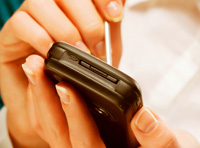Using cell phones as tools for learning actually began a few years ago, but a number of developments occurred in the last year to help accelerate this trend.
For one thing, smart phones have gotten even smarter. At an ed-tech industry summit in May, Qualcomm’s Peggy Johnson showed a graph indicating the growth over the last decade in MIPS (millions of instructions per second) that cell-phone chips can handle. The curve of the graph started rising steeply in 2004, when cell-phone chips could handle roughly 400 MIPS; today, that figure stands at nearly 2,000.
Today’s smart phones give users “all the power of a laptop in your pocket,” she said.
Cell-phone screens and battery life still remain challenges, Johnson acknowledged; the screens are very power-draining, and the developments in battery life haven’t been nearly as dramatic as the gains in chip sets. But Johnson revealed new advances in these areas, too, that could make mobile computing even more powerful.
Meanwhile, “augmented reality” has become a reality for a handful of smart-phone users, as San Diego’s School in the Park program demonstrated—and this development has interesting implications for teaching and learning. Apple’s new iPhone 4 and the Sprint HTC EVO are among new phones that include video chat capability—allowing users to conduct rudimentary video conferences on the go. And the new 4G networks being rolled out across the nation hold the promise for still more powerful applications.
Not everyone is convinced that smart phones are the future of educational technology.
One industry executive whose business involves netbooks and laptop computers, as opposed to cell phones, noted during the May summit that smart phones allow users to consume media and also collaborate with others—but they’re not as good at supporting content creation (a third important pillar of a 21st-century education). Plus, when you factor in the cost of the associated service, “the public sector can’t pay $45 per child, per year for a data plan,” she said.
Still, with the proliferation of smart phones among high school and college students, a growing number of schools are looking for ways to leverage this technology that many students already have. And there’s some evidence to suggest that these efforts are paying off: Two years ago, public high schools in North Carolina began a pilot program, called Project K-Nect, to determine whether smart phones and curriculum resources could help increase students’ math comprehension. Now, teachers are saying that not only have math test scores increased, but student achievement has increased in other subject areas as well.
Related links:
Survey: Teens’ cell phone use may cause tension with parents, schools [1]
Students soon could learn with handheld 3D devices [2]
Panel: Cell phones have much potential in classrooms [3]
Augmented reality takes hold in classrooms [4]
Can iPhone apps make kids smarter? [5]
New smart phones pave the way for mobile video chats [6]
Speech recognition, mobile apps help build reading skills [7]
Summit: Mobile computing is education’s future [8]
Program uses smart phones to increase math scores [9]
Apple offers app store discounts to schools [10]
School district, Verizon collaborate to incorporate cell phones into curriculum [11]
Purdue chosen for Verizon 4G rollout [12]
Survey: Mobile learning at a tipping point [13]
Launching a Mobile Learning Program: What Every School Leader Should Know [14]
